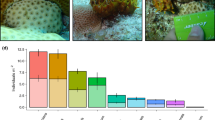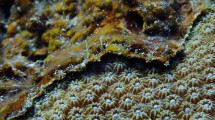Summary
Intraspecific competitive interactions were studied underwater in the Red Sea coralStylophora pistillata during 1976–1981, through a series of field observations (FO) and field experiments (FE). The FO series were conducted on more than 200 pairs of colonies (with a gap of 1–3 cm between the nearest branches in a pair), which were checked monthly for possible interactions, during approximately five years. The FE series consisted of allografts, isografts and colony to colony attachements.S. pistillata exhibits two basic colour morphs, in which purple colonics are found to be superior to yellow morphs and competitively exculde them, even when they are not physically touching. When differences in size between the competing colonies were in the range of 2–3 orders of magnitude, a significant superiority of big colonies over little ones was recorded, irrespective of colour morphs. Five major schematic routes of intraspecific interactions are drawn and discussed. The outcome of interactions between two competing colonies is the synergistic effect of different aggressive forms, such as nematocyst discharge, overgrowth on branches or basal plates, a “retreat growth” phenomenon (possibly caused by pheromones), formation of border lines, abnormal growth forms and others. SEM observations indicate the existance of a gap (up to 30 μm) between allografts that appeared to be fused in naked-eye observations and the appearance of plasmic (?) filaments immediately above and within the contact zones. In contrast to the FE series the FO were free from any stress caused by experimental procedures and provided the opportunity to record additional forms of aggression, which were not observed in the FE series. In many cases, the duration of processes and the final outcome of interactions were much faster in FE than in FO. It is concluded that intraspecific interactions involve significant energetic expenditures that otherwise would be channelled into other metabolic requirements such as reproduction and growth. Self-recognition mechanisms and the role of immunological processes are discussed. The FO series indicate that in the vast majority of interactions no physical contact (cell to cell) is needed for self-identification.
Similar content being viewed by others
References
Abe N (1937) Post larval development of the coralFungia actiniformis var.palawensis Doderlein. Palao Trop Biol Stat Studies 1:73–93
Atoda K (1947a) The larva and postlarval development of some reef building corals. I.Pocillopora damicornis cespitosa (Dana). Sci Rep Tohoku Univ 4th Ser (Biol) 18:24–47
Atoda K (1947b) The larva and postlarval development of some reef building corals II.Stylophora pistillata (Esper). Sci Rep Tohoku Univ 4th Ser (Biol) 18:48–64
Atoda K (1951a) The larva and postlarval development of some reef building corals. IV.Galaxea aspera Quelch. J Morphol 89:17–30
Atoda K (1951b) The larva and postlarval development of some reef building corals. V.Seriatopora hystrix Dana. Sci Rep Tohoku Univ 4th Ser (Biol) 19:33–39
Bigger CH, Runyan R (1979) An in situ demonstration of self-recognition in gorgonians. Dev Comp Immuno 3:591–597
Boschma H (1929) On the post larval development of the coralMaeandra areolata (L). Pap Tortugas Lab, Carnegie Inst Washington 26: 131–147
Dana TF (1976) Reef-coral dispersion patterns and environmental variables on a Caribbean coral reef. Bull Mar Sci 26:1–13
Duerden JE (1902a) West Indian Madreporarian polyps. Mem Natl Acad Sci Washington 8:401–597
Duerden JE (1902b) Aggregated colonies in Madreporarian corals. Am Nat 36:461–471
Gardiner JS (1931) Coral reefs and atolls. Macmillan, New York
Hildemann WH (1977) Specific immunorecognition by histocompatibility markers: The original polymorphic system of immunoreactivity characteristics of all multicellular animals. Immunogenetics 5:193–202
Hildemann WH, Linthicum DS, Vann DC (1975a) Transplantation and immunoincompatibility reactions among reef building corals. Immunogenetics 2:269–284
Hildemann WH, Linthicum DS, Vann DC (1975b) Immunoincompatibility reactions in corals (Coelenterata). In: Hildemann WH, Benedict AA (eds) Advances in experimental medicine and biology, Vol 64, Plenum New York, pp 105–114
Hildemann WH, Raison RL, Hall CJ (1977a) Immunocompetence in corals: Issues of specificity, memory and mechanisms. In: Solomon JB, Horton JD (eds) Developmental immunobiology. Elsevier, Amsterdam, pp 9–16
Hildemann WH, Raison RL, Cheung G, Hull CJ, Akaka L, Okamoto J (1977b) Immunological specificity and memory in a scleractinian coral. Nature (London) 270:219–223
Hildemann WH, Raison RL, Hull CJ, Akaka L, Okamoto J, Cheung G (1977c) Tissue transplantation immunity in corals. Proc 3rd Int Coral Reef Symp Miami, pp 537–543
Jackson JBC, Buss L (1975) Allelopathy and spatial competition among coral reef invertebrates. Proc Natl Acad Sci USA 72:5160–5163
Johnson IS, Jokiel PL, Bigger CH, Hildemann WH (1981) The influence of temperature on the kinetics of allograft reactions in a tropical sponge and a reef coral. Biol Bull 160:280–291
Knight-Jones EW, Moyse J (1961) Intraspecific competition in sedentary marine animals. In: Symposia of the Society for Experimental Biology, No 15: Mechanisms in biological competition. Cambridge University Press, Cambridge
Koch G (1982) Kleinere Mitteilungen über Anthozoen. 8. Aggregierte Kolonien vonBalanophyllia verrucaria Aut. Morphol Jahrb 18:376
Lacaze-Duthiers H (1899) Les Caryophyllies de Port-Vendres. Arch Zool Exp Gen Ser 3 V/7
Lamberts A (1973) Alizarin deposition by corals. Ph. D. Dissertation, University of Hawaii
Lang J (1971) Interspecific aggression by scleractinian corals. I. The rediscovery ofScolymia cubensis (Milne Edwards and Haime). Bull Mar Sci 21:952–959
Lang J (1973) Interspecific aggression by scleractinian corals. II. Why the race is not only to the swift. Bull Mar Sci 23:260–279
Lubbock R (1979) Mucus antigeneicity in sea anemones and corals. Hydrobiologia 66:3–6
Potts DC (1976) Growth interactions among morphological variants of the coralAcropora palifera. In: Mackie GO (ed) Coelenterate ecology and behaviour. Plenum, New York, pp 79–88
Potts DC (1978) Differentiation in coral populations. Atoll Res Bull 220:55–74
Richardson CA, Dustan P, Lang JC (1979) Maintenance of living space by sweeper tentacles ofMontastrea cavernosa, a Caribbean reef coral. Mar Biol 55:181–186
Rinkevich B, Loya Y (1979) The reproduction of the Red Sea coralStylophora pistillata. II. Synchronization in breeding and seasonality of planulae shedding. Mar Ecol Prog Ser 1:145–152
Sheppard CRC (1980) Coral cover, zonation and diversity on reef slopes of Chagos Atolls and population structures of the major species. Mar Ecol Prog Ser 2:193–205
Sokal RR, Rohlf FJ (1969) Biometry. Freeman, San Francisco
Stephenson TA (1931) Development and the formation of colonies inPocillopora andPorites, part 1. Great Barrier Reef Expedition, 1928–1929. Sci Rep 3:113–134
Stimson J (1974) An analysis of the pattern of dispersion of the hermatypic coralPocillopora meandrina varnobilis Verrill. Ecology 55:445–449
Theodor JL (1976) Histo-incompatibility in a natural population of gorgonians. Zool J Linn Soc 58:173–176
Whittaker RH, Feeny PP (1971) Allelochemics: chemical interactions between species. Science 171:757–770
Author information
Authors and Affiliations
Rights and permissions
About this article
Cite this article
Rinkevich, B., Loya, Y. Intraspecific competitive networks in the Red Sea coralStylophora pistillata . Coral Reefs 1, 161–172 (1983). https://doi.org/10.1007/BF00571193
Received:
Accepted:
Issue Date:
DOI: https://doi.org/10.1007/BF00571193




